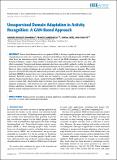Files in this item
Unsupervised domain adaptation in activity recognition : a GAN-based approach
Item metadata
| dc.contributor.author | Rosales Sanabria, Andrea | |
| dc.contributor.author | Zambonelli, Franco | |
| dc.contributor.author | Ye, Juan | |
| dc.date.accessioned | 2021-02-22T17:30:07Z | |
| dc.date.available | 2021-02-22T17:30:07Z | |
| dc.date.issued | 2021-01-22 | |
| dc.identifier | 272509284 | |
| dc.identifier | 0af0cffb-8335-4c79-b0b5-1eff7bfb5e8b | |
| dc.identifier | 85100471007 | |
| dc.identifier | 000619295700001 | |
| dc.identifier.citation | Rosales Sanabria , A , Zambonelli , F & Ye , J 2021 , ' Unsupervised domain adaptation in activity recognition : a GAN-based approach ' , IEEE Access , vol. 9 , pp. 19421-19438 . https://doi.org/10.1109/ACCESS.2021.3053704 | en |
| dc.identifier.issn | 2169-3536 | |
| dc.identifier.other | ORCID: /0000-0002-2838-6836/work/87404673 | |
| dc.identifier.uri | https://hdl.handle.net/10023/21482 | |
| dc.description | The work was supported by the Italian MIUR, PRIN 2017 Project ‘‘Fluidware,’’ under Grant N. 2017KRC7KT. | en |
| dc.description.abstract | Sensor-based human activity recognition (HAR) is having a significant impact in a wide range of applications in smart city, smart home, and personal healthcare. Such wide deployment of HAR systems often faces the annotation-scarcity challenge; that is, most of the HAR techniques, especially the deep learning techniques, require a large number of training data while annotating sensor data is very time- and effort-consuming. Unsupervised domain adaptation has been successfully applied to tackle this challenge, where the activity knowledge from a well-annotated domain can be transferred to a new, unlabelled domain. However, these existing techniques do not perform well on highly heterogeneous domains. This paper proposes shift-GAN that integrate bidirectional generative adversarial networks (Bi-GAN) and kernel mean matching (KMM) in an innovative way to learn intrinsic, robust feature transfer between two heterogeneous domains. Bi-GAN consists of two GANs that are bound by a cyclic constraint, which enables more effective feature transfer than a classic, single GAN model. KMM is a powerful non-parametric technique to correct covariate shift, which further improves feature space alignment. Through a series of comprehensive, empirical evaluations, shift-GAN has not only achieved its superior performance over 10 state-of-the-art domain adaptation techniques but also demonstrated its effectiveness in learning activity-independent, intrinsic feature mappings between two domains, robustness to sensor noise, and less sensitivity to training data. | |
| dc.format.extent | 18 | |
| dc.format.extent | 4155502 | |
| dc.language.iso | eng | |
| dc.relation.ispartof | IEEE Access | en |
| dc.subject | Human activity recognition | en |
| dc.subject | Domain adaptation | en |
| dc.subject | Ensemble learning | en |
| dc.subject | Generative adversarial networks | en |
| dc.subject | Covariate shift | en |
| dc.subject | Kernal mean matching | en |
| dc.subject | QA75 Electronic computers. Computer science | en |
| dc.subject | RA0421 Public health. Hygiene. Preventive Medicine | en |
| dc.subject | T Technology | en |
| dc.subject | 3rd-DAS | en |
| dc.subject | SDG 3 - Good Health and Well-being | en |
| dc.subject | SDG 11 - Sustainable Cities and Communities | en |
| dc.subject.lcc | QA75 | en |
| dc.subject.lcc | RA0421 | en |
| dc.subject.lcc | T | en |
| dc.title | Unsupervised domain adaptation in activity recognition : a GAN-based approach | en |
| dc.type | Journal article | en |
| dc.contributor.institution | University of St Andrews. School of Computer Science | en |
| dc.identifier.doi | https://doi.org/10.1109/ACCESS.2021.3053704 | |
| dc.description.status | Peer reviewed | en |
This item appears in the following Collection(s)
Items in the St Andrews Research Repository are protected by copyright, with all rights reserved, unless otherwise indicated.

